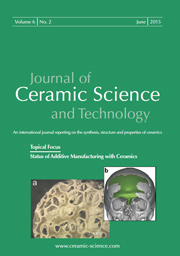Articles
All articles | Recent articles
Dense Yttria Film Deposited on a Plasma-Sprayed Al2O3 Coating by Aerosol Deposition
B.-K. Lee1, J.-H. Jung1, B.-D. Hahn1, W.-H. Yoon1, D.-S. Park1, J.-J. Choi1, J. Ryu1, J.-W. Kim1, C. Ahn1, K.-M. Song2
1 Functional Ceramics Research Group, Korea Institute of Materials Science, Changwon, Gyeongnam, 642 – 842, South Korea
2 Department of Applied Physics, Konkuk University, Chungju, Chungbuk, 380 – 701, South Korea
received July 21, 2011, received in revised form August 10, 2011, accepted August 23, 2011
Vol. 2, No. 4, Pages 197-202 DOI: 10.4416/JCST2011-00026
Abstract
Dense yttria (Y2O3) film was deposited on a plasma-sprayed alumina (Al2O3) surface by means of aerosol deposition (AD). The average surface roughness value (Ra) of the plasma-sprayed alumina was varied from 0.3 μm to 4.3 μm by grinding and grit-blasting with fine and coarse alumina abrasives. The ground alumina surface with an Ra value of 0.3 μm was too smooth for deposition of the yttria film by AD. A 30-μm-thick yttria film with 95.3 % TD was successfully deposited on the alumina surfaces with Ra values between 0.5 μm and 1.8 μm. On the other hand, the alumina surfaces with Ra values larger than 2.4 μm exhibited local areas where part of the alumina layer was removed by the grit blasting and microscopically smooth areas were exposed. Deposition of yttria by AD was not accomplished on those local areas. The results suggested that the optimum surface of the plasma-sprayed alumina should be microscopically rough to ensure strong adhesion of the yttria film onto the alumina surface during AD. The yttria film exhibited superior resistance to CF4 + Ar gas plasma erosion compared with the plasma-sprayed alumina coating.
![]() Download Full Article (PDF)
Download Full Article (PDF)
Keywords
Yttria film, alumina, surface roughness, grit blasting, aerosol deposition
References
1 Kitamura, J., Ibe, H., Yuasa, F., Mizuno, H.: Plasma-sprayed coatings of high-purity ceramics for semiconductor and flat-panel-display production equipment, J. Thermal Spray Tech., 17, 878, (2008).
2 Gansert, L.R.V.: Plasma-sprayed ceramic coatings, Ceram. Ind.,152, 48, (2001).
3 Kalkowski, G., Risse, S., Gyuenot, V.: Electrostatic chuck behavior at ambient conditions, Microelec. Eng., 61 – 62, 357, (2002).
4 Kim, D.-M., Kim, K.-B., Yoon, S.-Y., Oh, Y.-S., Kim, H.-T., Lee, S.-M.: Effects of artificial pores and purity on the erosion behaviors of polycrystalline Al2O3 ceramics under fluorine plasma, J. Ceram. Soc. Jpn., 117, 863, (2009).
5 Akedo, J.: Aerosol deposition of ceramic thick films at room Temperature: densification mechanism of ceramic layers, J. Am. Ceram. Soc., 89, 1834, (2006).
6 Iwasawa, J., Nishimizu, R., Tokita, M., Kiyohara, M., Uematsu, K.: Plasma-resistant dense yttrium oxide film prepared by aerosol deposition process, J. Am. Ceram. Soc.,90, 327, (2007).
7 Hahn, B.-D., Park, D.-S., Choi, J.-J., Ryu, J., Yoon, W.-H., Kim, K.-H., Park, C., Kim, H.: Dense nanostructured hydroxyapatite coating on titanium by aerosol deposition, J. Am. Ceram. Soc., 92, 983, (2009).
8 Hahn, B.-D., Kim, K.-H., Park, D.-S., Choi, J.-J., Ryu, J., Yoon, W.-H., Park, C.,Kim, D.-Y.: Fabrication of lead zirconate titanate thick films using a powder containing organic residue, Jpn. J. Appl. Phys., 47, 5545, (2009).
Copyright
Göller Verlag GmbH


